Here’s a look at the benefits AI customer segmentation, the results of my AI experiment, and some of the top tools you can use to streamline segmentation.
In this article:
The Benefits of AI Segmentation
Customer segmentation breaks your customer base into various subgroups. These subgroups can be based on multiple characteristics like:
- Demographics.
- Geographic location.
- Behaviors.
- Lifestyles, values, and interests.
- Needs.
This segmentation helps you better understand their needs and preferences. Then, you can create targeted messages that are more likely to resonate with your audience.
Here are the biggest benefits of AI customer segmentation.
Download Free Customer Segmentation Templates Today
1. Better Data Analysis
AI quickly sorts large data sets to provide an in-depth analysis. These in-depth analyses better inform your research. In fact, 63% of marketers use AI for market research today.
Think about that concerning customer segmentation. It’s likely your company has various groups of customers, each with their own needs and preferences. You can quickly and easily sort your customers using AI based on various defining characteristics.
Plus, AI can provide you with sentiment analysis, which helps you better understand how these customers feel about your product or service.
2. Bigger ROI
It’s no secret that personalization and segmentation are key to better marketing. Beyond that, with more advanced technology on the market, it’s expected. As technology advances, 73% of customers expect a personalized experience with a company.
Moreover, over half of consumers say they’ll become repeat buyers after a personalized experience. Using AI to segment your customer lists accurately can help your marketing and sales teams with revenue-driven strategies.
3. Improved Customer Retention
If customers are more likely to become repeat customers after personal experience with your brand, you also have a better chance of increasing customer retention. In fact, 62% of business leaders agree that improved customer retention is a benefit of personalization efforts.
AI can help you determine what your customer segments care about and how they feel about your product or service. Appealing to their preferences, interests, and needs is a great way to keep customers on your accounts.
4. Enhanced Predictions
Segmenting your customers into various groups can help you learn more about their behaviors and patterns and predict how they’ll behave. However, this can be a huge undertaking for one person, especially since it requires a large amount of historical data.
AI tools use historical and real-time data to predict your customers’ behaviors. This is especially helpful for planning proactive measures rather than reactive ones.
5. Saves Your Team Time
The amount of time saved by using AI tools might be the number one benefit of customer segmentation using AI. According to a Salesforce survey, marketers who use AI tools save an average of five hours per week.
Sure, that time likely accounts for content creation and other tasks, but it also accounts for market and customer research, including customer segmentation. What used to take hours to complete by hand now takes only a few minutes.
Not convinced? I ran a test to see if AI customer segmentation actually works — and it passed with flying colors.
Testing AI Segmentation
If I learned anything from my favorite professor in college, it’s this: always test things out. To see if AI can segment customers, I used ChatGPT. Here’s what happened.
The Scenario
I created a fictional health and wellness business to get the most out of using ChatGPT for customer segmentation. Then, I described my client base. Here are the most important details about my business, Fitness for You.
- The gym is open to:
- Enthusiasts and beginners
- Recreational members
- Age range: 18 to 80+
- Programs offered:
- Weight training
- Aerobics and water aerobics
- Yoga
- Cardio, including spin and treadmill classes
- Corporate programs
- There are more female clients than male clients.
- Some clients are members because of the social aspect of the programs offered.
Using this information, I want ChatGPT to sort my customers into the appropriate segments, including segments concerning:
- Fitness levels.
- Attitudes toward the gym.
- Program interests.
Running the Experiment
I first entered my company’s information to use ChatGPT for customer segmentation. The nice thing about ChatGPT is that it stores information, meaning there’s no need to keep reminding it of previous inputs.
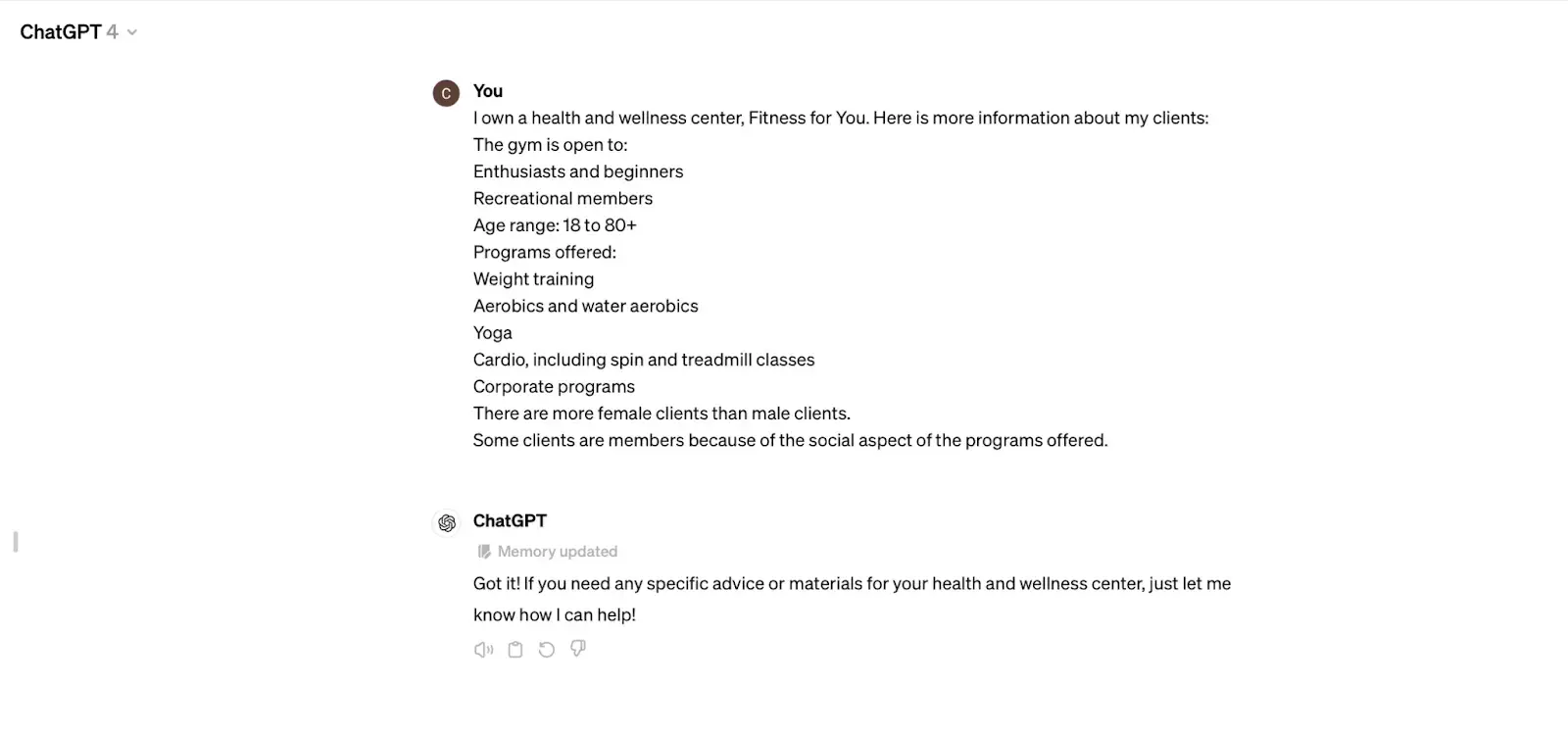
After entering my company’s information, I asked ChatGPT to segment my customers based on fitness level. The key to using AI tools is to be specific. This is the prompt I used:
- “Using my business information, segment my clients into groups based on their fitness level. Provide a description of my clients and their fitness level. Deliver the results in a table.”
Pro tip: I’ve found that asking ChatGPT to deliver results in a table makes them easier to read. Plus, copying and pasting the results into Google Sheets is easy.
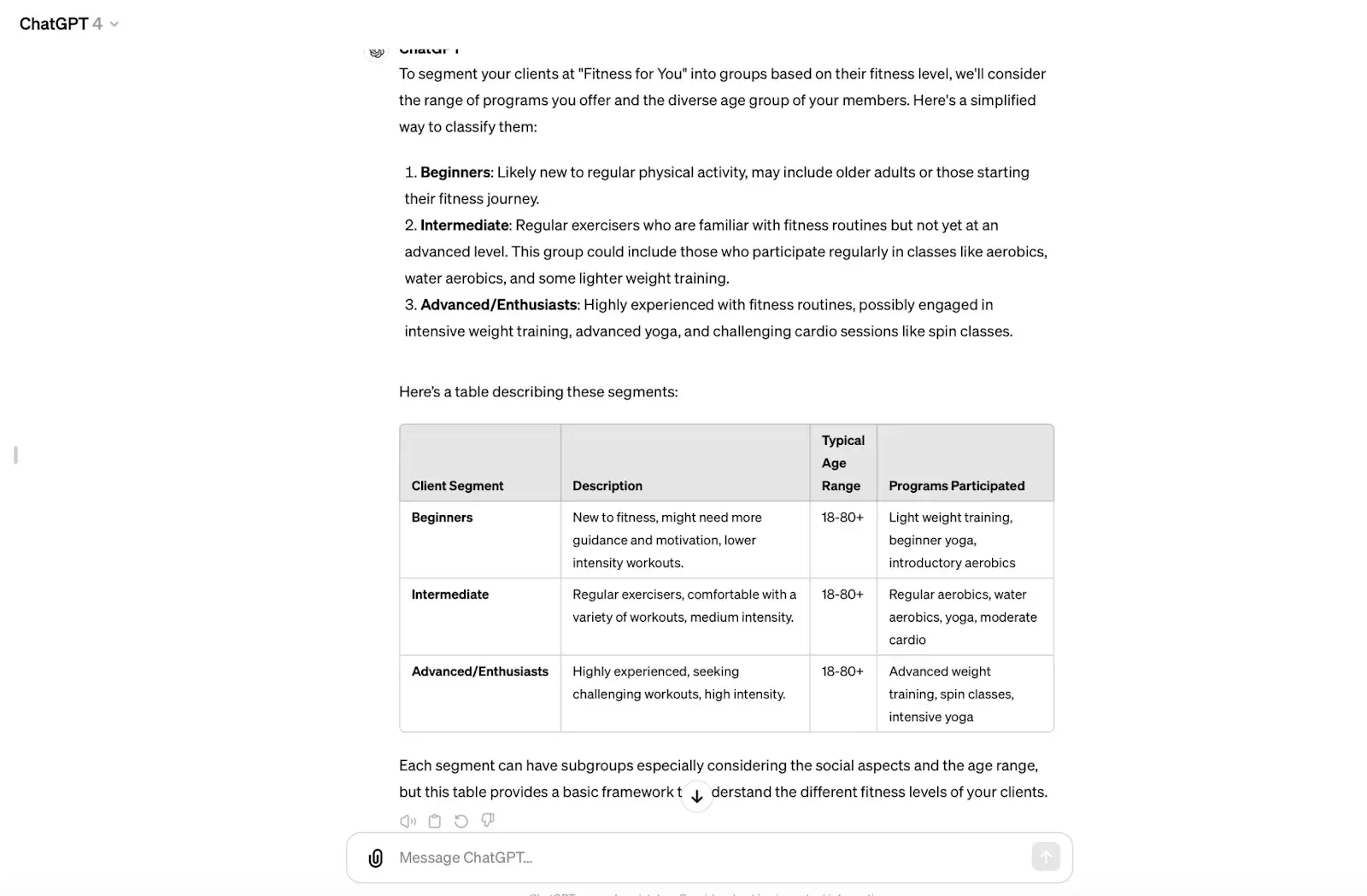
Next, I asked ChatGPT to separate my customers into groups based on their attitudes toward the gym. This is the prompt I used:
- “Using the same information about my customers and the segmented list, please segment them into groups based on their attitudes towards the gym.”
Here’s ChatGPT’s response:
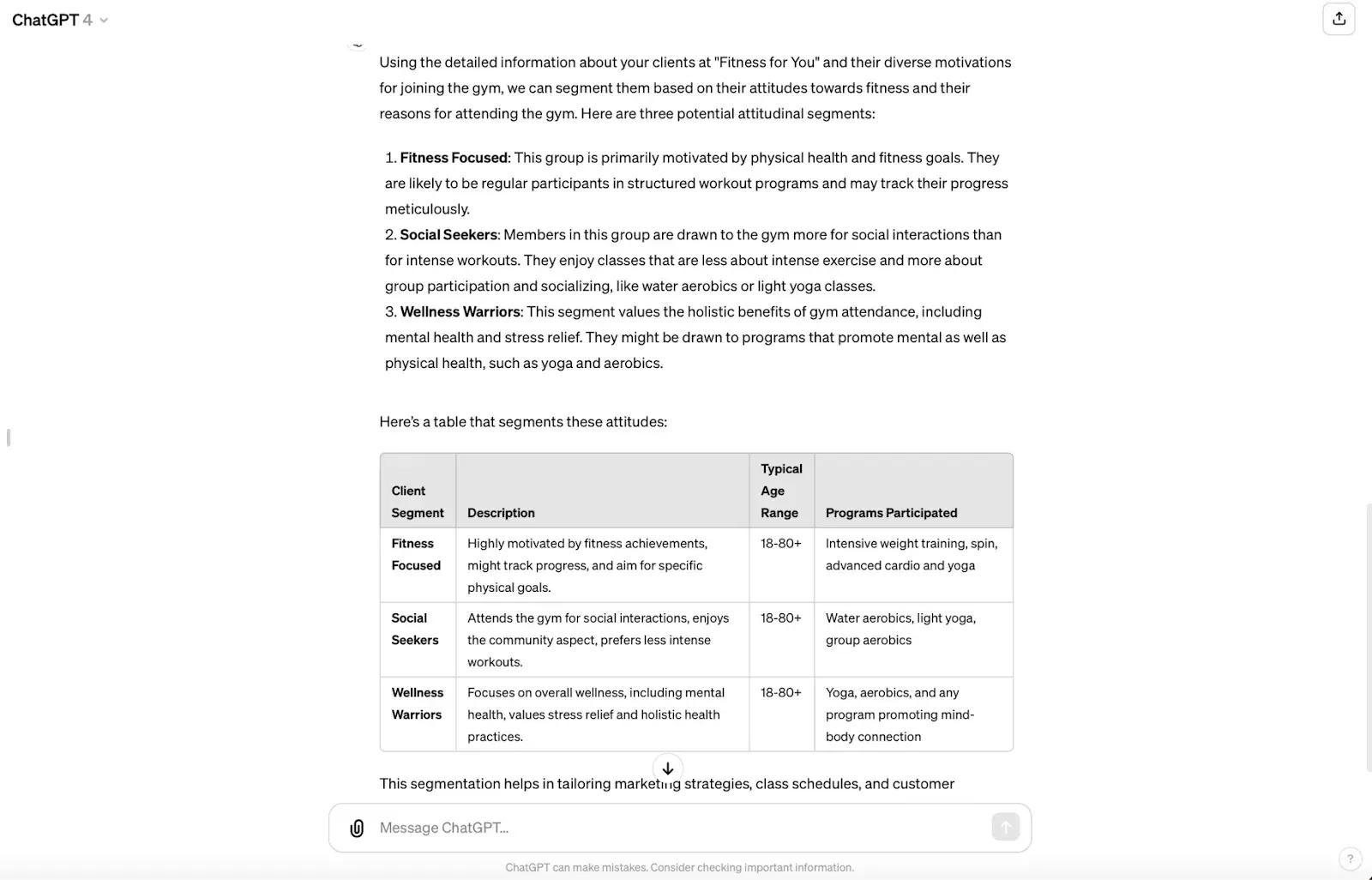
I like that ChatGPT continues to deliver the results in the table. I also appreciate that the response gives a description of my client segment and a guess about their preferences.
The final segmentation I want ChatGPT to generate is groups based on my clients’ gym program interests.
This is the prompt I used:
- “Using the segmented groups, perform another segmentation. This time, segment my clients into groups based on their program interests.”
Here’s the final response:
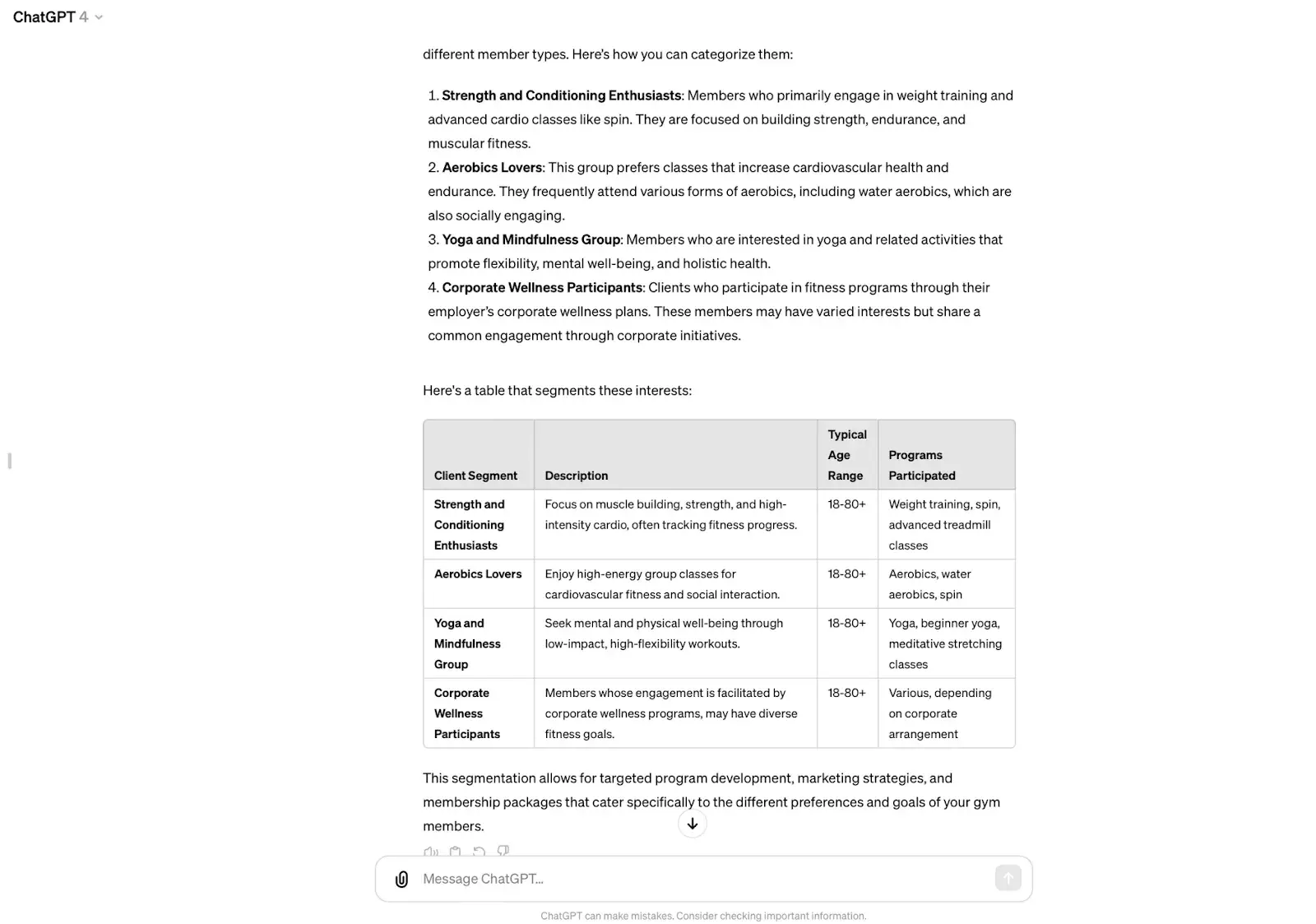
ChatGPT’s response categorizes my fictional clients based on their potential program interests and describes why those clients may be interested in the program. Knowing this information, I could easily create marketing campaigns based on their interests and preferences and, hopefully, gain loyal clients to my gym.
What I Learned
ChatGPT’s customer segmentation of my fictional clients was spot on.
If I wanted to create customer personas and hadn’t already done that, I could use the information provided to me by ChatGPT to create a persona for each customer segment. Or, if I was short on time, ChatGPT could create the user persona for me.
With more information, like age range and fitness goals, I could segment my clients further into more detailed groups. This would help me narrow down my focus for more accurate personalization and a better customer experience.
Key Takeaways
- Using the data provided, AI segmentation was accurate
- AI performs best with specific prompts and directions (use X data, display the output in Y format
- AI was capable of multiple levels of segmentationn and classification
AI Tools for Customer Segmentations
Looking for the best AI tools for customer segmentation? We’ve got you covered.
1. HubSpot AI
If you’re already a HubSpot CRM user, what are you waiting for? HubSpot AI is an easy-to-use AI tool that you can use throughout the customer platform.
With HubSpot’s CRM capabilities and HubSpot AI, you can create customer segments using historical and real-time data. Use this tool to create effective marketing campaigns, inform product development, and turn your customers into loyal fans.
What I like: I like that HubSpot AI is available at all points of the HubSpot customer platform. This means users get up-to-date information about their customer segments.
2. Optimove
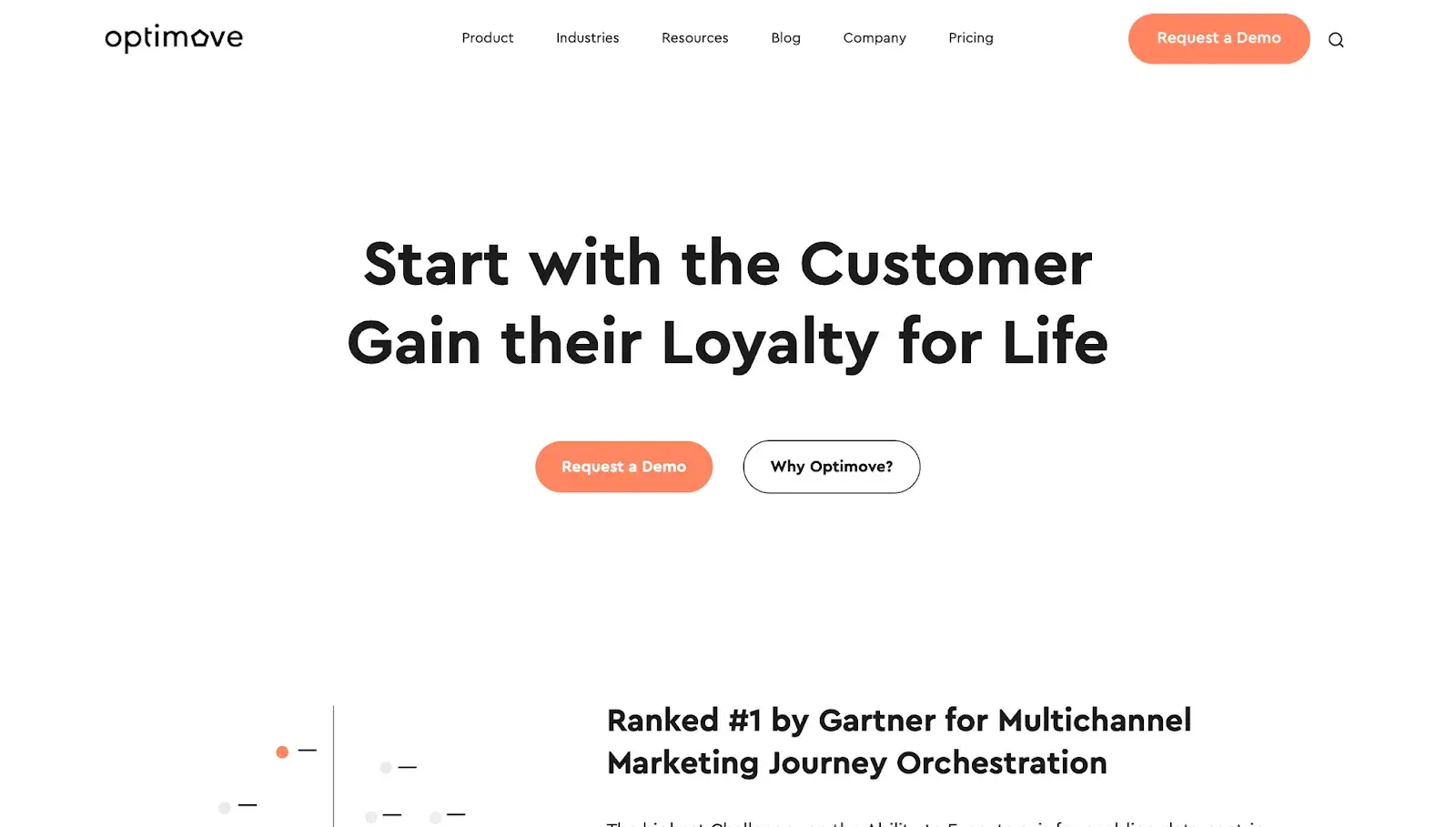
The more information you can obtain about your customers, the better. Optimove is a multi-channel engagement platform providing a comprehensive overview of your clients from four sources.
The platform uses cluster analysis and algorithms to separate customers into similar groups. Once the initial groups are identified, Optimove takes it further and creates sub-segments based on behaviors, demographics, and real-time interactions.
What I like: The nice thing about Optimove is that once you’ve segmented your audience, you can use control and test groups to A/B test marketing campaigns.
3. BlastPoint
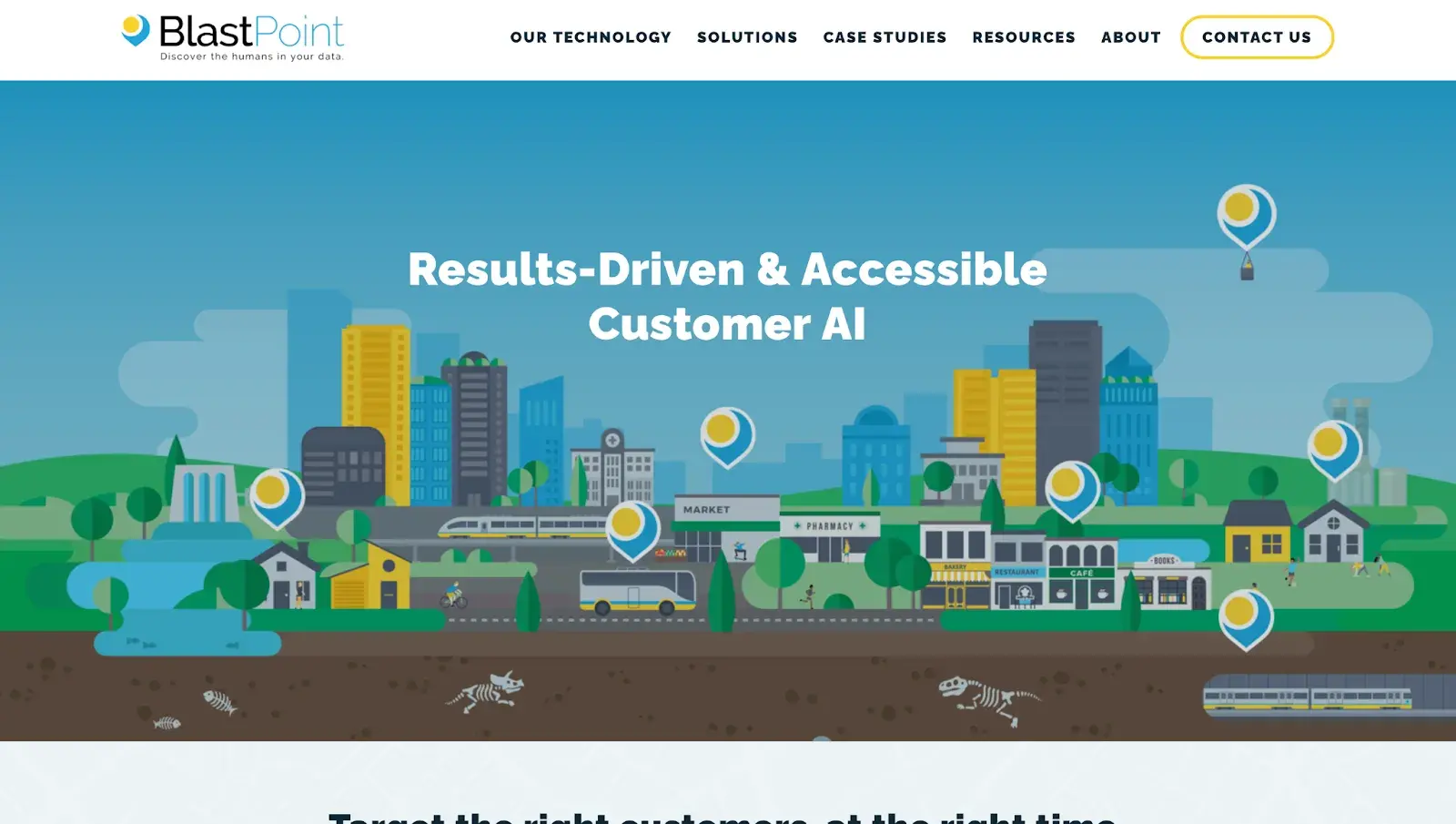
BlastPoint is an AI customer segmentation tool that provides optimized marketing solutions. It’s designed to help you understand your customers at a household level, meaning you’ll gain insights into their behaviors, demographics, and values.
The best part about BlastPoint is that, using its AI technology and your customer data, you can create as many filters as you need until you feel you have the appropriate customer segments.
What I like: I appreciate BlastPoint’s mission to help you become a more customer-centric company, regardless of industry.
4. Heap
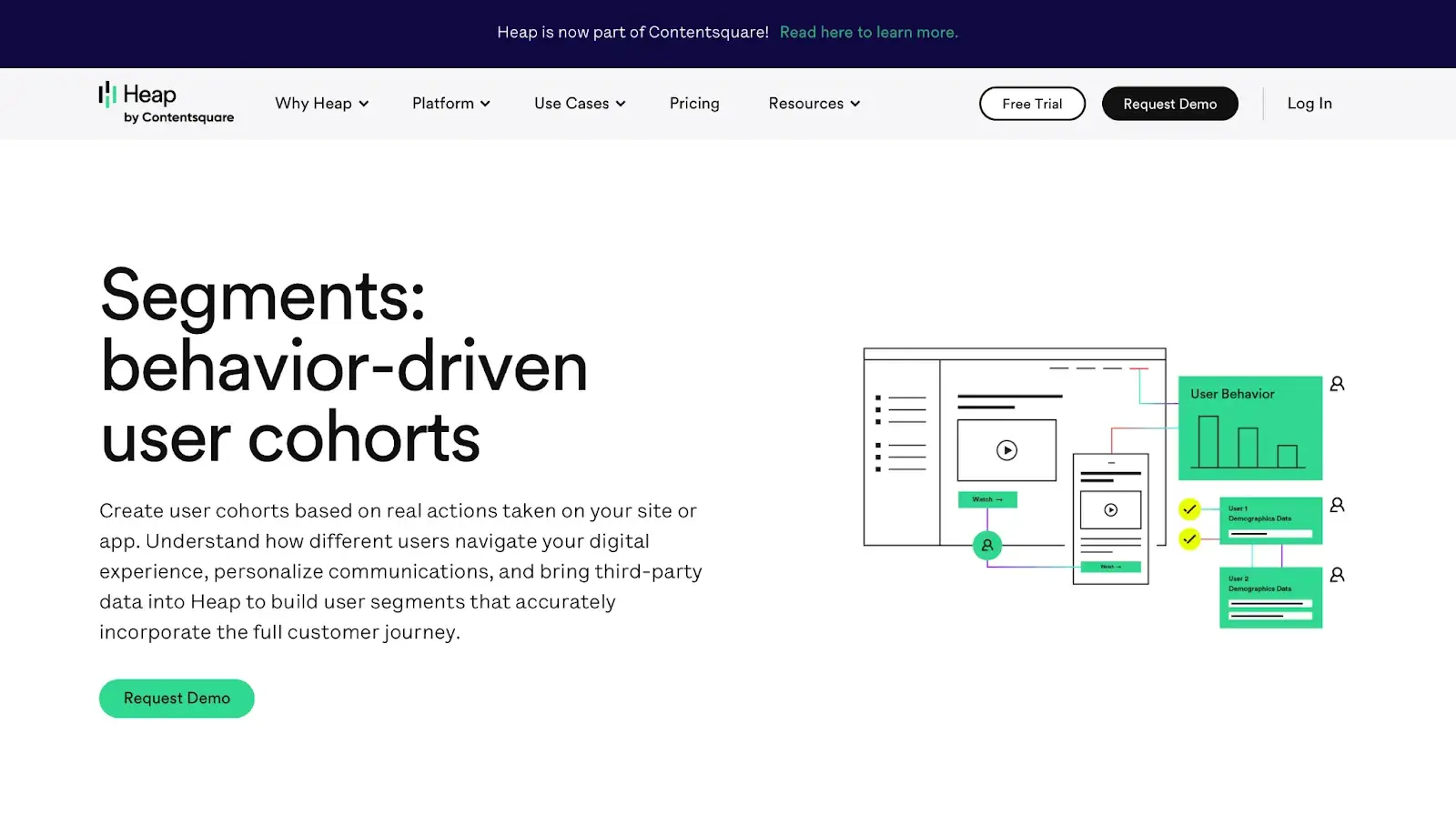
When considering customer segmentation, you might think of grouping clients based on characteristics, like demographics. Heap thinks about customer segmentation differently. Instead of segmenting customers based on their characteristics, Heap’s algorithm groups your audience based on their actions with your website.
Heap easily integrates with your existing technology, allowing you to create segments wherever your customers are. Heap also enables users to conduct A/B testing, create personalized campaigns, and build targeted user guides based on customer segment data.
What I like: I like that Heap focuses on actions rather than characteristics. Knowing this information is useful for creating user guides and a better knowledge base.
AI Segmentation Best Practices
Using AI for customer segmentation is an excellent way to identify the various customers on your accounts quickly. By understanding their actions and behaviors, you can boost conversions by providing relevant information and messages to your audiences.
If you plan to implement AI into your customer segmentation strategy, follow our experts’ and our best practices.
1. Define your goals.
You might choose to create a customer segmentation strategy for several reasons. For example, you might use it to redefine your marketing strategy or inform your business processes like Chuck Schaeffer, CEO of Johnny Grow.
Schaeffer’s team uses AI to dynamically map each customer into a customer segment. The segments can then be used to allocate resourcing and align business processes based on customer contribution.
For example, Schaeffer notes that the team may deliver high-touch customer support for high-contribution customers. Meanwhile, self-service support is available for low-contribution customers.
“Defining business processes by customer type or segment is extremely effective in growing revenues and margins from high-contribution customers and lowering cost-to-serve for low or negative-margin customers,” Schaeffer says.
Schaeffer’s team also uses AI to rank customer segments from most to least profitable.
“Identifying customers that contribute negative profits to the company creates an opportunity to plug those profit leaks. Reducing costs to serve these customers creates an alternative to discontinuing these customer relationships,” Schaeffer says.
2. Provide your AI tool with the most accurate data.
AI tools work best when your data is clean, error-free, and accurate. In my experiment asking ChatGPT to segment my fitness clients, I realized more data would have provided me with better results.
If you have the data available, use it. You might be surprised at the information you learn about your customers and their behaviors and preferences.
3. Catch customer interactions early and often.
Customer behavior will change throughout the customer journey. Collecting behavioral data when customers first interact with your company is best.
Ricardo Madan, senior vice president of TEKsystems Global Services, notes that these interactions — from inquiries, issue resolution, bill pay, order reconciliation, and problem — can inform AI and ML predictive analytics tools.
These insights “make these experiences more seamless for the users and more efficient or profitable for the companies they're working with,” Madan says. “All of this is optimized when the analytics effectively segment users earlier in the customer experience.”
4. Personalize, personalize, personalize!
One of the main reasons you should create a customer segmentation strategy is to provide relevant information to your audiences. Once you understand them, use what you’ve learned to your advantage.
Lisa Richards, CEO and creator of the Candida Diet, uses AI tools to help her create segmented lists. She sends better, more personalized messages to her audiences using the information about her lists.
Richards says, “Our AI engine uses customer data, such as transaction history, quiz responses, and browsing behavior, to segment customers by their candida severity and unique needs and prepare content chunked for their context.”
For example, those who are new to the Candida diet may receive easy-to-follow meal plans, while those who are already used to the diet may be served a different recipe recommendation.
“Implementing AI-powered segmentation has resulted in a 20 percent uplift in customer engagement with content, as users are now served up resources that are most relevant to them,” Richards says.
Can AI Segment Your Customers? Yes!
Customer segmentation helps grow your company and better understand your customers. You can uncover meaningful insights using AI and your company’s valuable data in a few minutes. Talk about time saved for your teams!
The trick to using AI is to ensure your data is clean and error-free. AI tools are only as good as your data, so keep that in mind when running customer segmentation prompts!
Editor's note: This post was originally published in January 2024 and has been updated for comprehensiveness.
Artificial Intelligence


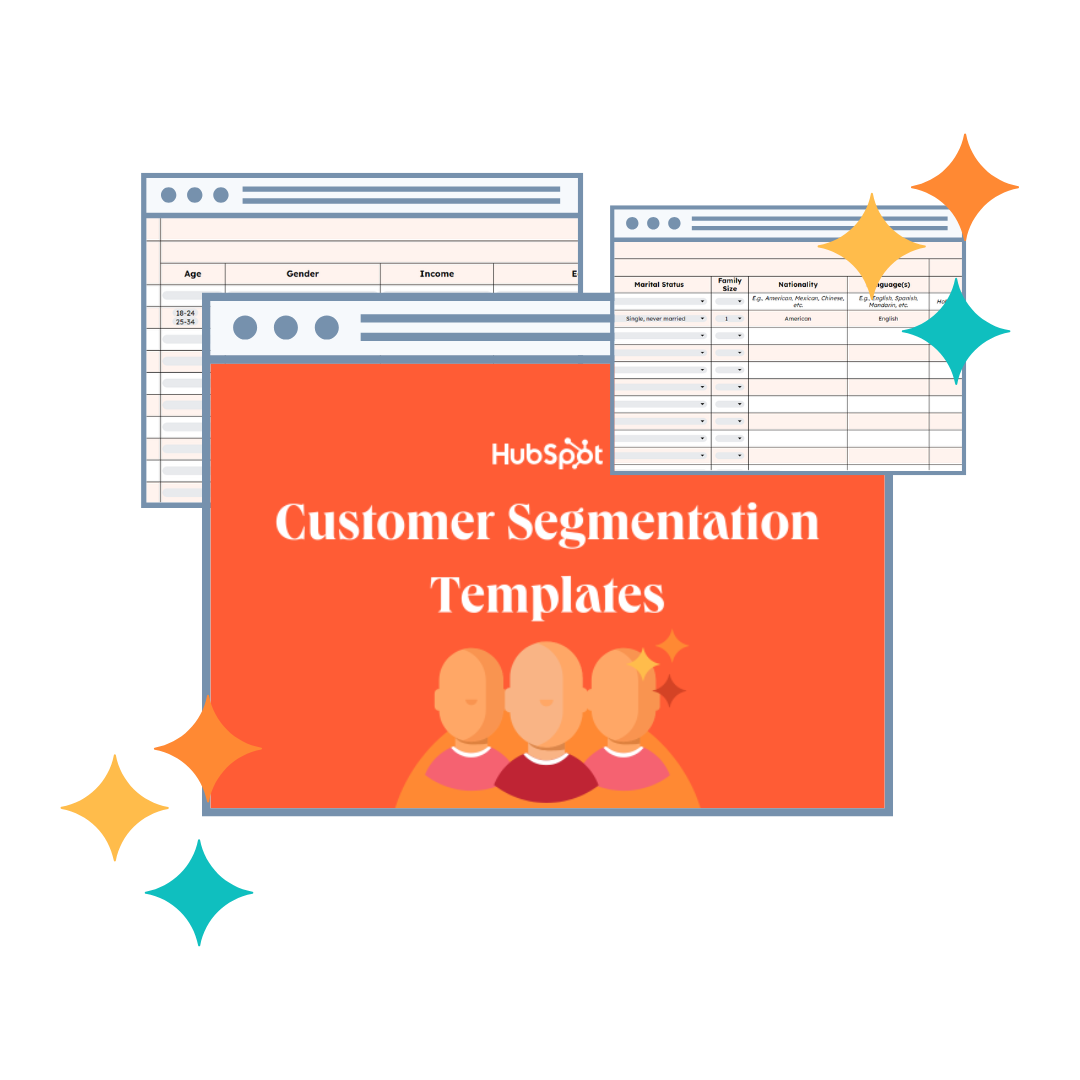
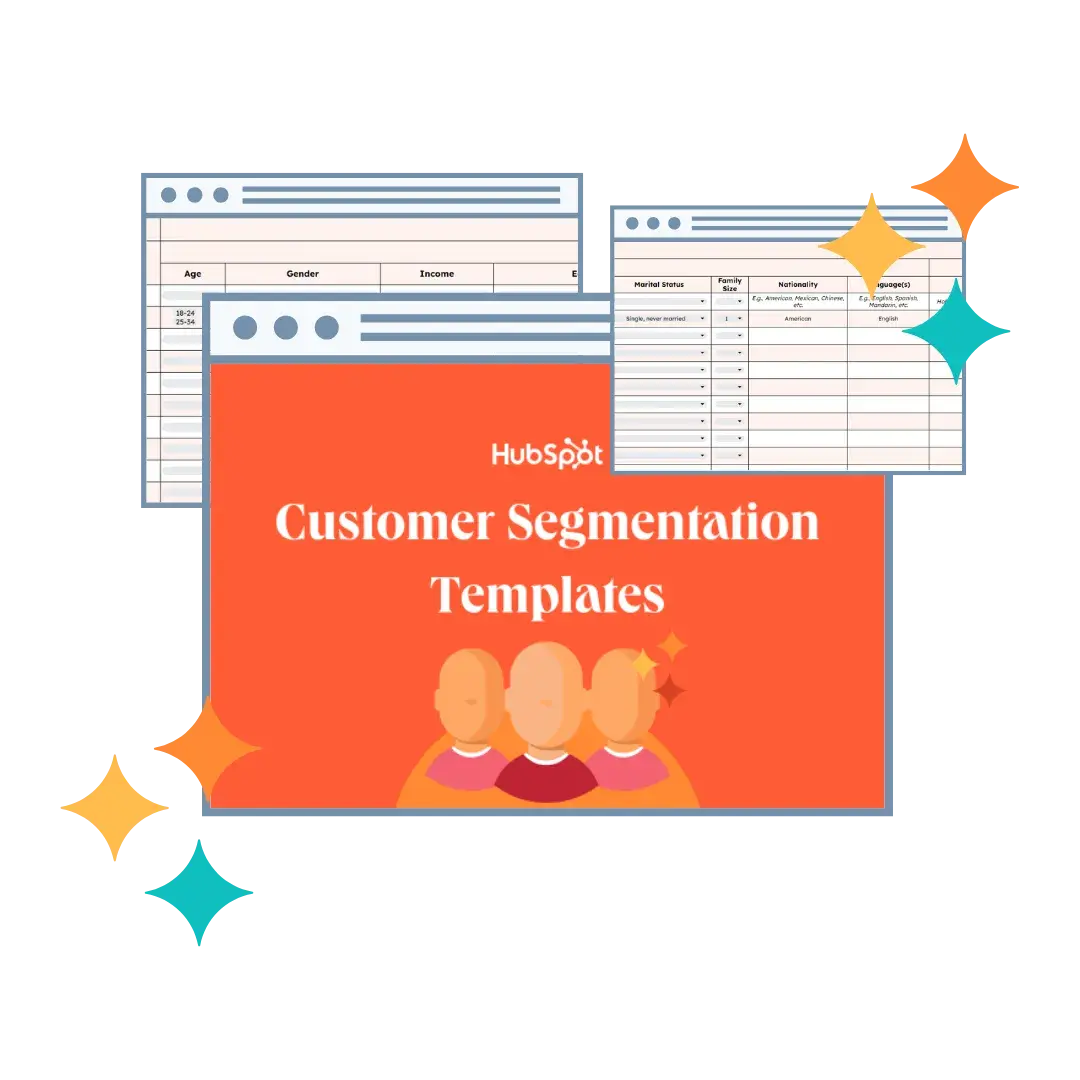

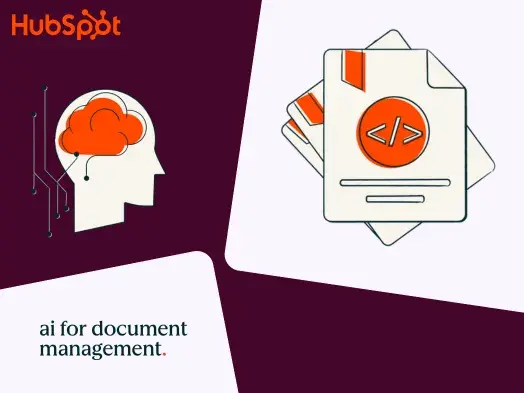
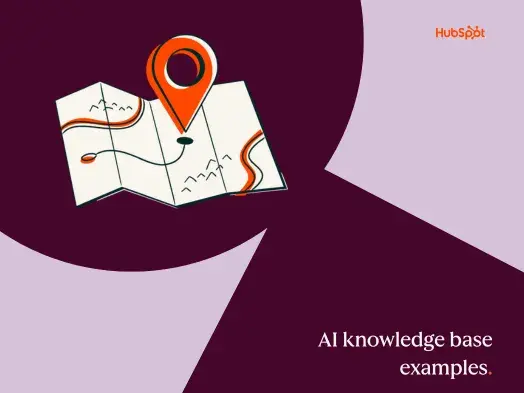
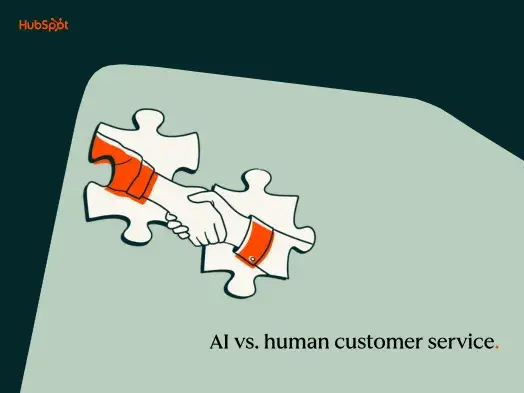

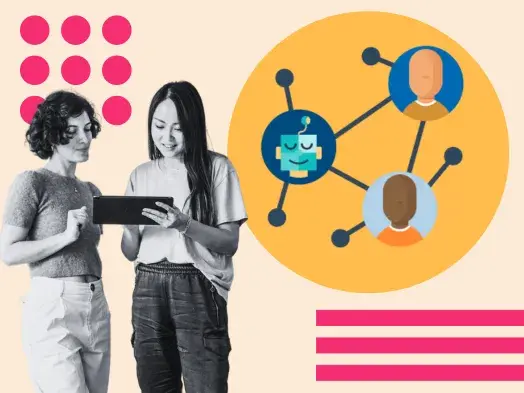
![How AI Can Unlock Customer Insights [+Expert Tips]](https://53.fs1.hubspotusercontent-na1.net/hubfs/53/customer-insights-ai-1-20241101-2082956.webp)



